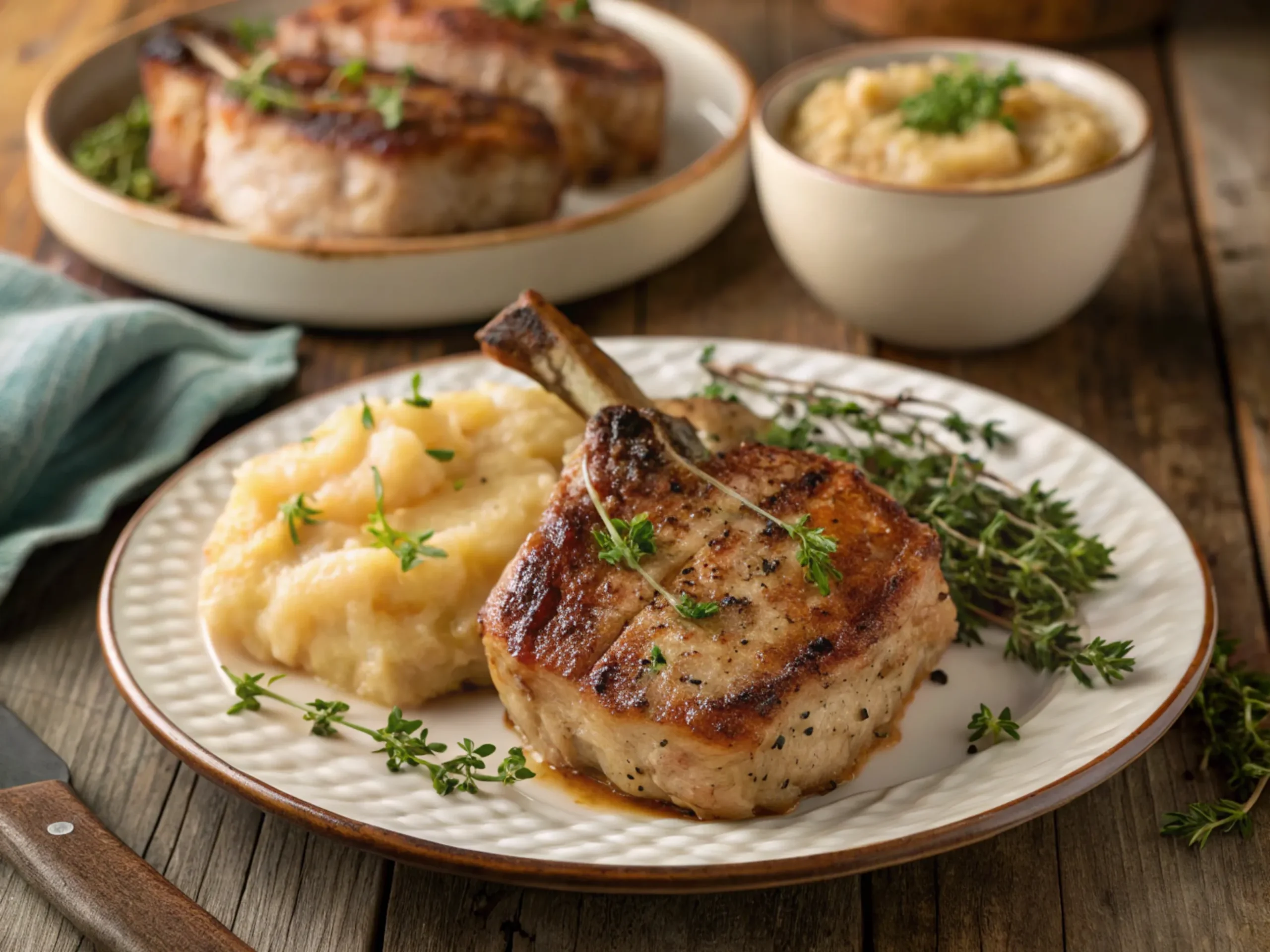Why did people eat applesauce with pork? This classic pairing has intrigued food lovers for generations. More than just a delicious combination, it carries deep historical, cultural, and culinary significance. People have enjoyed applesauce with pork not only for its perfect balance of flavors but also for its practical benefits in cooking. By exploring the origins and taste profile of this timeless duo, we uncover a rich tradition that continues to delight palates today.
One bite of pork with applesauce reveals the perfect harmony of sweet and savory. But why did this pairing emerge, and what makes it so beloved? Let’s delve into the fascinating history and culinary science behind the dish, alongside a mouthwatering recipe to try at home.
Table of contents
Origins of Applesauce and Pork Pairing
The combination of pork and applesauce is rooted in both necessity and tradition. Historically, apples were abundant in many regions, especially in Europe and North America, where pigs were also commonly raised. It’s one of the key reasons people eat applesauce with pork even today, as the pairing was both practical and flavorful. Apples could be stored long-term or turned into preserves like applesauce, making them an ideal accompaniment to pork dishes, particularly during the colder months.
The Influence of European Cuisine
In European cuisine, the pairing of sweet and savory flavors is a longstanding tradition. German culinary practices, for example, often combine fruits with meats to balance richness and cut through the fat. This influence traveled across the Atlantic with immigrants who brought their recipes and techniques, making applesauce and pork a staple in American households.
A notable example of this is the German dish Schweinebraten, where roasted pork is often served with apples or other fruits. Similarly, British cuisine features roast pork with apple sauce as a classic Sunday dinner. These traditions continue to influence how we enjoy pork and applesauce today.
Learn more about similar traditions at “Apple Cider Vinegar Pork”.
Practicality Meets Flavor
Beyond tradition, practicality played a significant role in the dish’s rise. Applesauce provided a convenient and affordable way to enhance the flavor of pork, which was often a tougher and fattier meat in earlier times. The sweetness and acidity of applesauce helped to tenderize the pork and add depth to the dish, cementing its place in family dinners and special occasions alike.
Moreover, applesauce was an effective way to use up an overabundance of apples during harvest season. By pairing it with pork, households could create a meal that was both economical and satisfying. This combination became especially popular during the fall, a time when apples were harvested, and pork was often prepared for winter storage.
Why Did People Eat Applesauce with Pork? The Perfect Flavor Balance
The magic of this pairing lies in its balance of flavors and textures. Applesauce provides a sweet, tangy counterpoint to the savory richness of pork, which explains why people eat applesauce with pork to create a sensory experience that is both satisfying and dynamic.
The Science of Flavor Pairing
The combination of sweet and savory is scientifically proven to stimulate the palate. The natural sugars in applesauce interact with the umami and saltiness of pork, creating a taste profile that feels complete and indulgent. Additionally, the acidity in apples helps cut through the fat, cleansing the palate with every bite.
The texture of applesauce also plays a role. Its smooth, velvety consistency contrasts with the firm, juicy texture of pork, offering a delightful interplay of mouthfeel. This contrast enhances the overall dining experience, making each bite more memorable.
Nutritional Benefits
Applesauce isn’t just a flavor enhancer—it also offers nutritional benefits. The natural pectin and fiber in apples can aid digestion, especially when paired with a rich protein like pork. Apples are also a source of antioxidants and vitamins, which complement the protein and iron found in pork.
For those looking to balance indulgence with health, this pairing is a delicious compromise. By using unsweetened or lightly sweetened applesauce, you can reduce added sugars while still enjoying the dish’s full flavor. Additionally, substituting butter for olive oil when cooking the applesauce can make the dish even healthier.
Ingredients for Pork and Applesauce
Crafting the perfect pork and applesauce dish starts with high-quality ingredients. It’s no wonder people eat applesauce with pork to enjoy the balance of sweet and savory in a truly flavorful meal. Below is a simple yet flavorful recipe to try at home.

| Ingredient | Amount | Notes |
|---|---|---|
| Pork chops | 4 | Bone-in or boneless, as preferred |
| Apples (Granny Smith) | 4 | Peel and core before cooking |
| Brown sugar | 2 tbsp | Optional for added sweetness |
| Cinnamon | 1 tsp | Enhances the natural apple flavor |
| Butter | 2 tbsp | For sautéing apples |
| Salt and pepper | To taste | For seasoning the pork |
Optional Additions
- Nutmeg (¼ tsp): Adds a warm, spicy note.
- Fresh thyme: Use as a garnish for added aroma and flavor.
- Apple cider vinegar (1 tbsp): Enhances the tanginess of the applesauce.
Step-by-Step Recipe

Preparation Steps
- Season the Pork Chops:
Generously season the pork chops with salt and pepper. Allow them to rest at room temperature for about 15 minutes. - Prepare the Applesauce:
- In a skillet, melt butter over medium heat.
- Add sliced apples, cinnamon, and brown sugar (if desired).
- Sauté until the apples are tender and caramelized, then mash slightly to create a rustic applesauce. For a smoother texture, blend the mixture until creamy.
- Cook the Pork Chops:
- In a separate pan, sear the pork chops over medium-high heat until golden brown on each side (about 3-4 minutes per side).
- Transfer to a preheated oven at 375°F (190°C) and cook for an additional 10-12 minutes or until the internal temperature reaches 145°F (63°C).
- Combine and Serve:
- Plate the pork chops and top them with a generous dollop of homemade applesauce. Garnish with fresh herbs like thyme or parsley for an elegant finish.
Discover more about creating perfect flavor combinations in our “Pork and Apple Casserole Recipe” .
Creative Variations
For those who love experimenting in the kitchen, the classic pairing of pork and applesauce is the perfect starting point. It’s easy to see why people eat applesauce with pork, as its versatility allows for endless creative possibilities. Add spices like ginger or nutmeg for a warm, autumnal twist, or incorporate pears for a unique flavor profile. Slow-cooked pork belly paired with spiced applesauce is another delicious variation worth exploring.
Another creative option is to marinate the pork in apple cider or apple juice before cooking, intensifying the apple flavor. For an even more indulgent dish, try pairing applesauce with crispy pork belly or roasted pork tenderloin.

Common Mistakes When Cooking Pork and Applesauce
While pork and applesauce may seem like an easy combination, certain mistakes can detract from the final dish. Avoid these common pitfalls to ensure a perfect meal every time.
Overcooking the Pork
Pork can quickly become dry and tough if overcooked. Use a meat thermometer to monitor the internal temperature, ensuring it reaches exactly 145°F (63°C). Resting the meat after cooking is equally important, as it allows the juices to redistribute.
Using Overly Sweet Applesauce
Store-bought applesauce often contains added sugars, which can overwhelm the pork’s savory flavor. Opt for unsweetened or homemade applesauce to achieve a more balanced taste. If you prefer a touch of sweetness, use natural ingredients like honey or maple syrup sparingly.
Skipping the Seasoning
Seasoning both the pork and the applesauce is critical to developing depth of flavor. A simple blend of salt, pepper, and spices like cinnamon or paprika can elevate the dish significantly.
Discover more seasoning tips in our “What Apples Go Best with Pork” .
Choosing the Wrong Apples
Not all apples are created equal for cooking. Varieties like Red Delicious are too soft and sweet, resulting in a mushy, overly sugary applesauce. Instead, use tart and firm apples like Granny Smith or Fuji for optimal results.
Pro Tips & Variations for Pork and Applesauce
Enhance your dish with these creative twists and expert suggestions. Whether you’re looking to experiment with flavors or streamline the process, these tips will help you take your cooking to the next level.

Incorporating Seasonal Flavors
- During autumn, add seasonal spices like nutmeg, allspice, or clove to your applesauce for a cozy, festive twist.
- In summer, try grilling the pork chops and serving them with a fresh apple slaw instead of traditional applesauce.
Pairing with Sides
Pork and applesauce pair beautifully with sides that complement their flavors. Consider creamy mashed potatoes, roasted root vegetables, or a crisp green salad with vinaigrette.
Slow-Cooked Perfection
Using a slow cooker allows the flavors of pork and applesauce to meld together over time, resulting in a tender, flavorful dish. Add onions, garlic, or herbs like rosemary for added complexity.
Creative Serving Ideas
- Serve pork and applesauce on a bed of quinoa or wild rice for a modern, health-conscious twist.
- For a gourmet presentation, layer sliced pork with dollops of applesauce and drizzle with a reduction of balsamic vinegar.
Explore slow-cooked recipes in our “Best Apples for Pork” .
Frequently Asked Questions About Pork and Applesauce
To round out your understanding of this iconic pairing, here are answers to frequently asked questions, blending historical insight and practical advice.
Why is pork served with applesauce?
Pork is served with applesauce because the sweetness and tanginess of applesauce balance the savory, fatty nature of pork. This pairing dates back to traditional European cuisines, where fruits often accompanied meats to enhance their flavor profiles.
Why is apple paired with pork?
Apple is paired with pork due to its acidity, which helps cut through the richness of the meat. Additionally, the natural sugars in apples caramelize beautifully, complementing pork’s umami taste.
Where did pork chops with applesauce come from?
This pairing originated in Europe, particularly in Germany and Britain. It became a staple in American cuisine as immigrants brought their culinary traditions to the New World, adapting them to local ingredients.
What meat do you eat applesauce with?
While pork is the most common pairing, applesauce also works well with poultry such as chicken or turkey. Duck, with its rich, fatty profile, is another excellent option that benefits from applesauce’s acidity.
What are the best apples for pork?
The best apples for pork are tart and firm varieties like Granny Smith, Honeycrisp, and Braeburn. These apples maintain their structure during cooking and provide a balanced contrast to pork’s richness.
Can you use flavored applesauce with pork?
Flavored applesauce, especially those with cinnamon or cloves, enhances the dish. However, avoid overly sweetened varieties, as they can overpower the pork. Homemade applesauce allows for greater control over the flavors.
Is applesauce good for pork marinades?
Yes, applesauce can be used as a base for marinades, especially when mixed with spices, garlic, or apple cider vinegar. Its natural acidity tenderizes the meat, while its sweetness adds depth of flavor.

Conclusion
Pork and applesauce are more than just a classic pairing—they are a celebration of balance, history, and culinary creativity. From their European roots to their enduring popularity in modern kitchens, this combination continues to captivate taste buds and inspire new interpretations. It’s easy to see why people eat applesauce with pork, as the pairing brings harmony to every bite.
By following the tips, recipes, and variations shared in this article, you can master the art of pairing pork with applesauce and elevate it into a dish that delights every palate. Whether you prefer a traditional preparation or an innovative twist, this iconic duo offers endless possibilities for culinary exploration.

